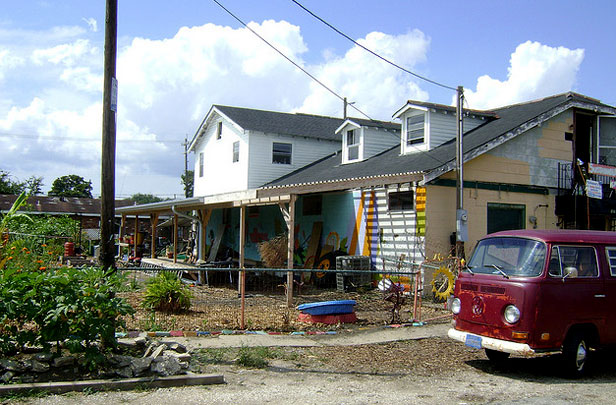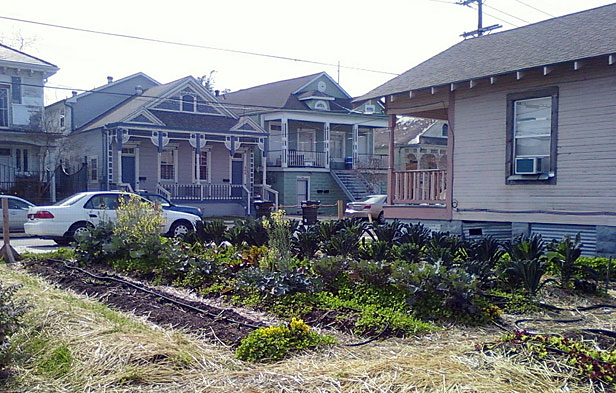
Little Sparrow Farm was born on a long-vacant lot in Mid-City New Orleans, surrounded by the area’s traditional shotgun houses. (Photo by eustatic.)
The Feeding the City series is profiling several cities with thriving urban-agriculture and alt-food scenes.
In the land of gumbo and beignets and crawfish and rabbit-n-dumplings, of Haitians and French and Anglos and Africans, life moves at a slower pace, with more color and spice than most of America. There’s time for food and music, and for parties to celebrate both.
New Orleanians have always taken pride in all things local, but since Katrina and now the oil spill creeping in from that blessed and cursed Gulf of Mexico, that pride has swelled immeasurably from Gulf shrimp to Ninth Ward greens to edible schoolyards.
Things grow here. And people know how to grow and how to cook. Hard-core foodies could take a week to sample the white-table-cloth restaurants relying on serious local sourcing. The chefs from Bayona, Coquette Bistro, Dante’s Kitchen, Cochon, M Bistro, Herbsaint, and Patois are becoming regulars at city farmers markets. Emery Von Hook, director of markets for the organization Market Umbrella, sees chefs all over the produce stands.
“It’s certainly picked up after Katrina,” she says. “There’s an accelerated sense of pride in local cuisine, local ingredients. It’s like an act of solidarity.”
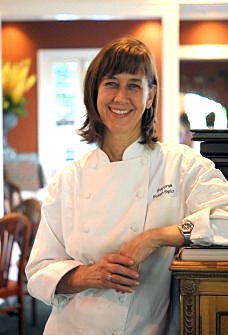
Chef Susan Spicer has founded several restaurants that feature not just New Orleans food, but locally grown and caught ingredients — which is why she is suing BP over the oil spill’s effect on local seafood. (Photo by asante_mag.)
The chefs are joined by local residents, and not just Uptowners, either. Thanks to a new Market Match program, shoppers with food stamps get matched dollar-for-dollar, up to $25 per market visit (there are three markets per week, and they can receive funds for each). Last year’s pilot program matched $10,000 in stamps.
This is a land of opportunivores, however — it’s not all squash and okra and tomatoes down here. Seafood has always been a centerpiece of a southern New Orleans meal. But prices have risen. Gulf shrimp used to cost $3 per pound, but in recent years it’s gone up to $17 per pound. That was even beforethe oil spill, which has finally reached its greasy fingers into Lake Ponchartrain, the last major outpost for shrimp and crabs.
“Usually we have three seafood vendors at our Crescent City Farmer’s Market,” says Von Hook. “They sell Louisiana shrimp, crawfish, brim, crabs. One has stopped coming — they’re having a hard time finding help to run their traps since people are taking BP clean-up jobs. Another vendor, who’d been coming until a few weeks ago, went west to Cameron to try to pull shrimp out of there.” The third is still coming, she says, “but who knows; it depends on all the openings and closings in the different fishing areas.” (Led by New Orleans culinary icon Susan Spicer, a group of restaurant owners is suing BP over the spill’s effect on their local-seafood business.)
A lot of fishermen live in east New Orleans’ Village de l’Est neighborhood, a community of 6,000 Vietnamese who arrived here with the Catholic Church following the Vietnam War. Their backyards and canal-sides overflow with greens, fruits, and root vegetables brought from their homeland. Elderly residents grow produce for their families and for sale at the local markets. (For a closer look, see my post in the Breaking Through Concrete series on Grist.) No one knows that the city’s best pho — and a serious national contender for best food-security model — live here, between the pavement of Highway 90 leading out of New Orleans and the wetlands that drain Lake Ponchartrain. And all this despite the fact that the wetlands have been soured by an emergency post-Katrina landfill that illegally accommodated highly toxic waste, which, of course, leaked into the shallow groundwater system and canals. It’s all documented in the film A Village Called Versailles.
Knowing is half the battle. One of the common problems with all these new food projects spread throughout the micro-worlds of cities is awareness of who’s what and where, and how to get there. To help, the New Orleans Food and Farm Network (NOFFN) has been putting together a book to be published this fall. Growing Back to Our Roots will be a collection of essays, maps, and photographs of the backyard gardens, community gardens, grocery stores, and markets growing and/or selling New Orleans-grown food. It will be both a celebration of this city’s rich food and garden tradition and a resource to find all the varied projects like the Edible Schoolyard, where chef April Neujean is using two gardens at two public charter schools to drive a national discussion on food policy and schools. Or NOFFN’s own Holly Grove farm and market, or the Midcity community garden.
Like Detroit, New Orleans has the sense of a wild laboratory, the open-sided, free-air market for food security discussions and, above all, action. It’s partly because of Katrina’s ruin, but it’s also just part of the culture.
Three of the city’s most interesting experiments:
Viet Village Urban Farm
East New Orleans, Village de l’Est neighborhood
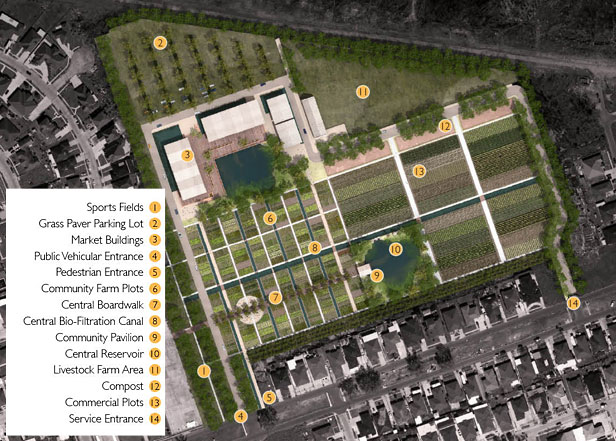
A Tulane University rendering of the proposed Viet Village Urban Farm complex. (Mary Queen of Vietnam CDC; click to enlarge.)
What:A planned urban farm, market, community space, and meat processing plant on 19 acres.
Roots of the project: Father Nguyen, the visionary priest at the Village de l’Est’s Mary Queen of Vietnam Catholic Church, saw the men and women farming the wetlands beyond the levee for years. Since Katrina, the lowlands have become more flooded and difficult to cultivate.
The idea for an urban farm project here began in a Tulane University landscape architecture class. Their plans were so good, and the idea so smart, that the New Orleans firm Spackman, Mossop, & Michaels, took it over. Their model has hit it big with an exhibit in New York’s Cooper-Hewitt Museum.
(Future) harvest: The $6 million project will cover 28 acres and include community plots, quarter-acre market farm plots for commercial growing, a storm-water reservoir, and composting. It will incorporate a covered market space for produce sales and a livestock grazing area, plus a small meat processing plant for immediate, direct meat production and sales. It’s an aggressive idea that marries shiny American design with the old-world institution of growing food to sell and eat.
Currently, the Viet Village is in a holding pattern. Since it will be developed on wetlands, the project must undergo the Corps of Engineers’ environmental assessment process. But first, a permit must be obtained through the mitigation bank, a third-party stewardship agreement managed by, in this case, Chevron. The mitigation bank stipulates that its owner, Chevron, must enhance the environmental quality of the property in perpetuity. So, if something goes wrong — contamination, habitat loss, etc — Chevron, not the Viet Village farm, is responsible. This would be the same if a golf course came onto the property, an outlet mall, or a small organic farm.
Chances of contamination and subsequent cost to Chevron from a 19-acre urban farm, of course, are minimal. And yet because of the “risks,” the cost to get the permit is $380,000 — check payable to Chevron. The Mary Queen of Vietnam CDC has reached out to Chevron for help in reducing the costs, but Chevron — which purchases mitigation banks as a means of generating good PR — has refused. Unfazed by the oil companies that make New Orleans life difficult by sea and by land, Lauren Butz, the Environmental Justice Coordinator and Viet Village Urban Farm Project Manager, is moving ahead and confident they will raise the funds the buy the permit and build the farm.
“The development plan is complete; the business plan got sidetracked by the oil spill,” says Lauren. “But we’re starting to fundraise. In an ideal world, we’d break ground in 2011, realistically 2012.”
Adopt-a-Mirliton
Greater New Orleans and throughout the Gulf Coast
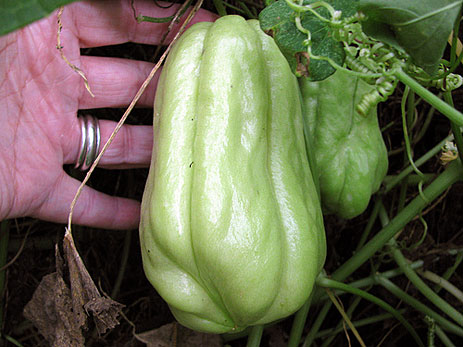
The mirliton, aka chayote, is a millennia-old gourd. (Photo by Lance Hill.)
What: An effort to repopulate New Orleans with the once popular and productive mirliton (aka chayote) fruit, pronounced “mello-ton.”
Roots of the project: Lance Hill started growing mirlitons about 30 years ago. “A neighbor gave me one, and it was the ultimate lazy person’s vegetable. You just plant it and don’t have to weed or feed it. It’s a climbing vine, so it naturally trellises onto a bench, then wanders up into the tree above. Sometimes I’m lazy enough that I don’t even have to pick it; I just sit on the bench under the tree and wait for one to fall in my lap.”
The mirliton is 60 million years old, a gourd that has floated the globe, landing and thriving on most continents and even Hawaii. Its potato-like fruit and its prolific propagation capabilities helped escaped slaves survive on Africa’s Reunion Island. It arrived in New Orleans with the Creoles — French-sympathizing Haitians who fled the island following its independence from France. Mirlitons grew like crazy in city backyards. They hung over sidewalks next to fig and pecan trees, and they became a staple in the cuisine, stuffed with shrimp or buttered like a potato. Then Katrina’s salt water wiped them out.
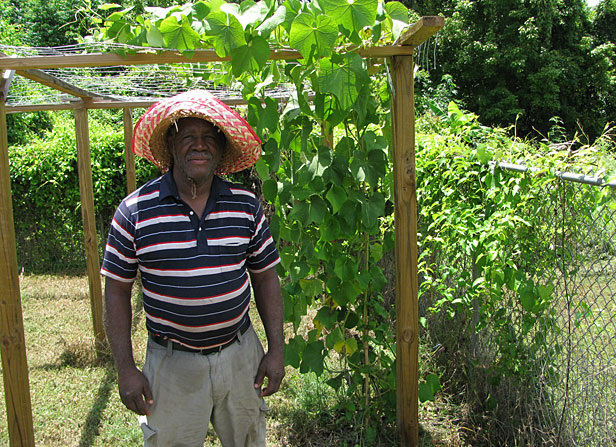
Leo Jones stands next to his mirliton trellis in Harvey, Louisiana, documented as part of the adopt-a-Mirliton project. (Photo by Lance Hill.)
Harvest: Lance is also a historian, so when the mirlitons disappeared after Katrina and the grocery-store varieties wouldn’t take, he dug into the situation. Lance likes the fruit, but even more, he likes the plant’s traditional place in the cuisine of New Orleans and southern Louisiana. In 2007 he tracked down an original heirloom variety, planted it, and wrote a grower’s guide.
His fertilization worked. Lance has now distributed over 250 mirliton seeds or plants in the city, mainly via the Crescent City Farmers Market. He’s traveled throughout Acadiana identifying nine heirloom varieties. And the desire for mirlitons followed Katrina refugees throughout the Gulf Coast and Houston: he’s spread the mirliton love in 26 cities and 5 states.
School at Blair Grocery
The Ninth Ward, New Orleans
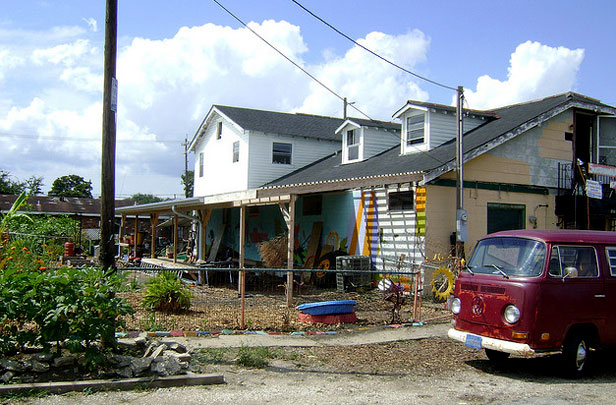
Crops grow behind the alternative School at Blair Grocery. (Photo by rgb86.)
What: A program to engage high-school dropouts in the good-food revolution via partnership with the national Youth Coalition for Community Action.
Roots of the project: The School was founded in 2008 by Nat Turner, a former New York City public high school teacher who moved to New Orleans with a mission to open an alternative school. He’d seen drop-out levels rise sharply since Katrina and had grown frustrated with the number of kids on the streets who couldn’t read. Nat started working with six students; they planted and grew vegetables at the old Blair Grocery, a former grocery store and the first black-owned business in the Lower Ninth Ward.
Harvest: Turner believes that “instead of these kids going to jail, we can have them involved in the cutting edge of the good food revolution” and with luck, lead into the alternative school system. He knows how youth work, especially youth who’ve fallen out of the traditional school system. They need mentors in their peer group. So he’s partnered the School at Blair Grocery with the Youth Coalition for Community Action. This means that over 500 high-school and college students from cities and colleges around the country come to NOLA and work with his students on good-food projects.
“When I bring in fun, engaging, committed high school and college students from Los Angeles and San Francisco and New York, and Oberlin and Wesleyan Colleges, my kids want to hang with them and do what they’re doing,” says Turner. “Basically, everybody has to eat. It takes time. Some kids respond really well. It depends what it is. They’ll eat salad if you put ranch dressing on it. If it’s dumped on top of fresh-cut, mixed radish sprouts that are cut right here, then it’s very nutritious.”

